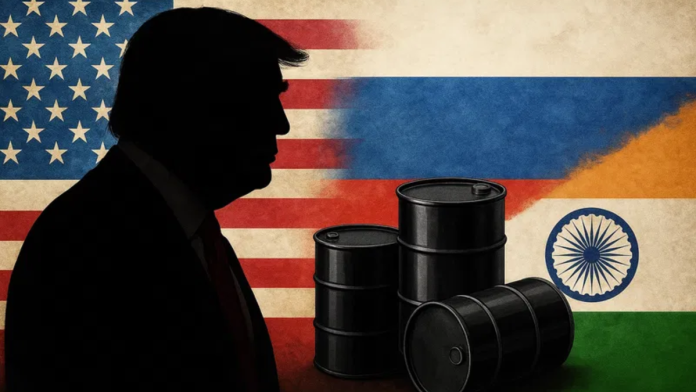The trade tensions between India and the United States have reached a boiling point. In a move that has sparked strong reactions from New Delhi, US President Donald Trump has imposed an additional 25% tariff on Indian goods. This new penalty directly targets India’s continued oil trade with Russia, which the Trump administration sees as a challenge to its global policy on Moscow.
India has fired back, calling the decision “unfair, unjustified, and unreasonable,” and made it clear that national interest and energy security remain its top priorities — regardless of international pressure.
Tensions Rise as Trump Imposes New Tariffs on India
The United States, under President Donald Trump, has announced a fresh 25% tariff on Indian imports. This comes just days after a similar tariff was rolled out, making it a combined 50% duty on several Indian products entering the US market.
This decision follows a signed executive order targeting countries that continue purchasing crude oil from Russia. India has been openly buying discounted oil from Moscow since the Russia-Ukraine war began, citing the need to ensure affordable energy for its 1.4 billion citizens.
The Ministry of External Affairs (MEA) in India reacted sharply, stating that it is “extremely unfortunate” for the US to penalize India for actions taken purely out of economic necessity. The statement also highlighted that other countries are also trading with Russia in their own interest and are not facing similar penalties.
Trump’s 50% tariffs backfire? Modi reaches toward China with surprise SCO return after 7 years
India pointed out that its decision to buy Russian oil was influenced by global shifts. Traditional suppliers began redirecting shipments to Europe due to the ongoing conflict. The MEA said that even Washington had earlier supported these imports to help stabilize energy markets.
India’s Energy Security at the Heart of the Dispute
India depends on imports for nearly 88% of its crude oil needs. Before 2021, Russian oil made up only a tiny portion of India’s total crude purchases. But after Western sanctions led to price drops, Indian refineries began buying more from Russia to cut costs.
As of July 2025, Russia has become India’s top oil supplier. India imported around 5 million barrels per day, with approximately 1.6 million barrels coming from Russian sources alone. This shift has allowed India to maintain stable fuel prices domestically, something it considers vital for its economy and citizens.
The Trump administration’s latest decision affects almost all Indian imports, sparing only a few sectors like steel, aluminium, pharmaceuticals, and semiconductors. Countries like Malaysia and Vietnam face tariffs between 20% and 25%, while China and Bangladesh face up to 35%. But India and Brazil are now subject to the highest level of import duty — 50%.
This steep tariff puts Indian goods at a clear disadvantage in the US market. Despite this, Indian authorities have made it clear they will not compromise on the nation’s energy strategy.
Trump warns Russia of new sanctions on shadow fleet if ceasefire is not reached
India Stands Firm Amid New Sanctions Threat from Trump
Further tightening the pressure, Donald Trump has warned of possible secondary sanctions. These would target any nation or company helping Russia indirectly through trade — such as through energy partnerships.
In the executive order titled “Addressing Threats to the US by the Government of the Russian Federation,” Trump stated that India’s continued oil dealings with Russia justify the additional 25% duty. The order also clarified that this new charge is “in addition to any other duties, fees, taxes, or charges.”
The first 25% tariff went into effect on August 7, 2025. The new 25% tariff will be enforced on August 27, leaving Indian exporters with just three weeks to adjust.
Despite the looming sanctions, the Indian government has refused to back down. The Ministry of External Affairs reaffirmed that all decisions are made keeping national interests in mind. The statement firmly added that India will take all necessary steps to safeguard its economy, its people, and its strategic needs.
India has stood its ground, showing no signs of yielding to international pressure — even from one of its most powerful trade partners. As tensions mount, the world watches closely how the situation between Donald Trump’s administration and India unfolds.


